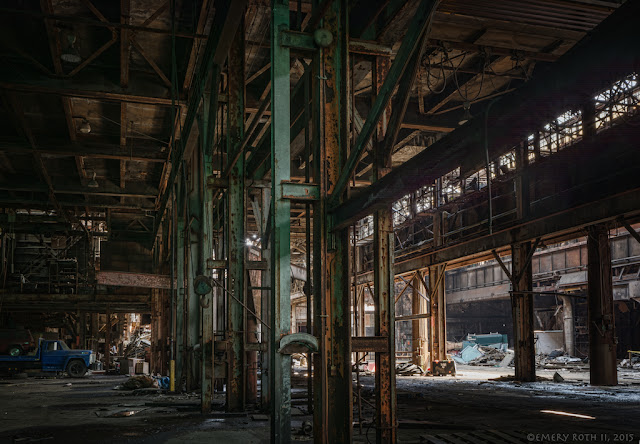PHOTOGRAPHER’S JOURNAL: To me, it has always been the “Bread Yard,” though I’m quite certain there was never more bread here than it takes to supply a few workers' lunch boxes. The bread crane, with its vine-covered hook and its shantytown cab as photographed from above through that chain link fence in 2011, drew me to Farrel Foundry. (http://rothphotos.blogspot.com/2011/06/farrels-hook.html) At the time I had no idea whether the Bread Yard was within Farrel or was on the property of the neighbor to the north, Ansonia Copper & Brass.
After searching unsuccessfully at Ansonia Copper & Brass, it was one of the first places I tried to find when I briefly got inside Farrel Foundry in 2011, and I found it. However, it was so clogged with semi-trailors that I realized the best photo had been the one I took through the links of the fence, though I had thrown away thousands of pixels.
Bread or no bread, it was a senseless place to put a yard for semis, hemmed in on all sides and at farthest remove from street or rail, a place only reached by bringing semis through the busy, dirty, danger-filled center of the foundry with cranes shuttling 60 ton castings overhead.
The reason for the Bread Yard lies hidden beyond the tin building at the back of this picture, in a space like the secret compartment on an old desk, and accessible behind an unused building at Ansonia Copper and Brass. It was another year before I found my way to the long pool that lay between the buildings of Ansonia Copper and Farrel. Even when I saw it I was too dense to realize that the pool and pump house marked the aborted end of the old Ansonia Canal which still flows from the Kinneytown dam, a mile and half north, and which once continued south, before there was a pump house, through the Bread Yard and on along one edge of Farrel Foundry beside Main Street, then crossing under Main Street and the firehouse and flowing south, eventually looping back to the river. The eastern bay of Farrel sheds and the Bread Yard had been built where the canal once flowed.
Finally, last fall the semis were removed, all but the bread truck, and I took a number of pictures of the Bread Yard through which the canal once flowed, though the vine that had filagreed the hook was long gone. When the bread truck is gone, will there be cake?






